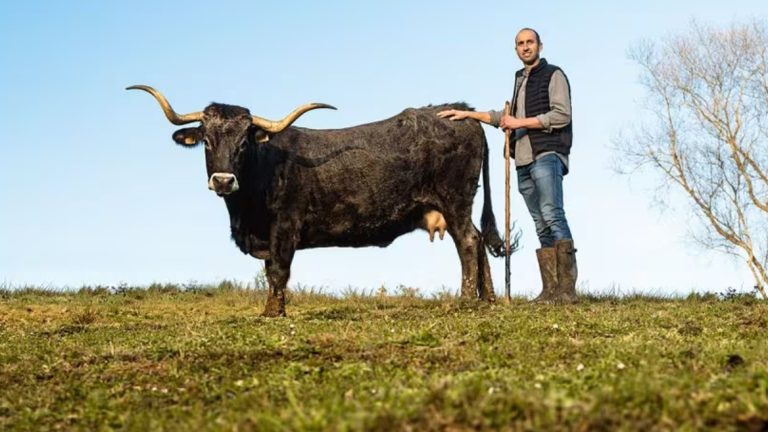Introduction: The Tudanca Breed
The Tudanca cattle breed holds a revered status in Cantabria, often likened to the esteemed Wagyu of Cantabria. Just as Wagyu cattle are known for their marbled meat and the meticulous care provided by their breeders, Tudanca cattle share similar characteristics with their intramuscular fat and the tender care they receive from their farmers. Thanks to the dedication of new generations of sustainable family farmers, the native Cantabrian cow, with its imposing stature akin to that of the Spanish fighting bull, roams freely in the high mountains, overcoming the threat of extinction. Over the past decade, the breeding and culinary use of Tudanca cattle have seen a surge. Their lean and flavorful meat has become synonymous with high-quality, exquisite cuisine.
Culinary Delights: From Tradition to Innovation

From traditional dishes like solomillo with beetroot and Tresviso cheese to modern creations like katsu sando made with Tudanca snout, the versatility of Tudanca beef in culinary arts is remarkable. Local chefs, adorned with stars and accolades, proudly feature Tudanca beef on their menus, showcasing the rich flavors that embody the essence of Cantabria.
Chef Antonio Vicente, a staunch advocate of Tudanca cuisine for the past 14 years, emphasizes, “It tastes like Cantabria. Like the pastures where it spends half of the year, freely grazing, imparting flavors reminiscent of wild game, which feeds in the same locales.” Manuel Quintana, a fourth-generation farmer and butcher, echoes this sentiment, stating, “You can perceive flavors of thyme, rosemary, from what the cow has eaten its whole life.” Quintana’s innovative approach includes crafting Tudanca Jamón, awarded three stars at the Great Taste Awards 2023. Unlike León’s smoked beef, Tudanca Jamón undergoes a meticulous curing process, utilizing various cuts of the leg, enveloped in salt, and aged for months before being coated with a lard made from the cow’s kidney fat and air-dried in his grandfather’s attic.
In addition to Tudanca Jamón, Quintana produces chorizo and salchichón, utilizing meat and fat from the chest, seasoned with mild Murcian paprika. The liver of the cattle is transformed into a delectable pâté, showcasing the versatility of Tudanca beef in various culinary creations.
From Pasture to Plate: The Journey of Tudanca Beef

The journey of Tudanca beef begins with its upbringing in the pristine landscapes of Cantabria. Maria Montesino and Lucio González, owners of La Lejuca, a ranch located in Alto Ebro, emphasize the significance of grass-fed beef, available seasonally from spring to early autumn. They assert the importance of respecting the natural rhythms of cattle, eschewing hormones, and allowing calves to graze on maternal milk.
“In a time of vegetal obsession, the choice is to eat less meat, but of superior quality,” opine Montesino and González, underscoring the intensified flavors and tender texture of grass-fed beef. Quintana, with his herd of 300 Tudanca cattle, emphasizes the importance of a natural upbringing, allowing the cattle to graze freely in the mountains before a final stage of fattening with barley and corn on a large farm.
The Environmental Impact of Tudanca Cattle
Beyond its culinary value, Tudanca cattle play a crucial role in the ecosystem of the region. Pablo Palencia, the regional councilor for Rural Development, Livestock, Fisheries, and Food, emphasizes the need to promote Tudanca beef consumption both within and beyond Cantabria, acknowledging its environmental contributions in maintaining pasturelands and mitigating the risk of wildfires.
Preservation Efforts and Future Prospects
Currently, Cantabria boasts a population of over 16,000 Tudanca cattle, predominantly concentrated in the regions of Cabuérniga, Liébana, and Campoo. While there was a period when foreign breeds overshadowed indigenous ones, there’s now a renewed focus among young farmers on prioritizing quality over quantity.
The Unique Traits of Tudanca Cattle
Tudanca cattle, with their distinctive large horns, closely resemble the ancient aurochs, the Eurasian ancestor of modern cattle. Their rugged disposition, adeptness at climbing, and adaptability to harsh terrains make them invaluable assets in the mountainous landscapes of Cantabria. Renowned for their resilience to cold weather and their ability to thrive in natural environments, Tudanca cattle are cherished for their intelligence and robustness.
The Vision for Tudanca Beef: Quality and Sustainability
As advocates for sustainable agriculture and food sovereignty, Maria Montesino and Lucio González envision a future where small-scale, grass-fed beef production takes precedence, ensuring the welfare of both animals and the environment. Their participation in initiatives like De Granja en Granja underscores their commitment to organic farming practices and the promotion of ethically sourced Tudanca beef.
Conclusion: Tudanca Beef – A Culinary Treasure
In conclusion, Tudanca beef stands as a testament to Cantabria’s rich gastronomic heritage and its commitment to sustainable farming practices. From its humble origins as a resilient mountain breed to its status as a culinary delicacy enjoyed by gourmands and chefs alike, Tudanca beef embodies the essence of Cantabrian cuisine. As consumer preferences shift towards ethically sourced, high-quality meat, Tudanca beef emerges as a shining example of tradition, innovation, and environmental stewardship. Whether savored in a rustic tavern or featured on the menu of a Michelin-starred restaurant, Tudanca beef promises an unforgettable dining experience, steeped in the flavors of Cantabria’s pristine landscapes and centuries-old culinary traditions.



